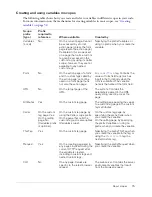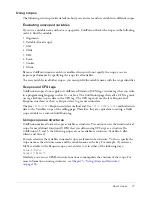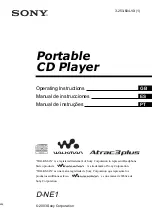
86
Chapter 4: Using Expressions and Pound Signs
Alternative notation for decision operators
You can replace some decision operators with alternative notations to make your CFML more
compact, as shown in the following table:
Decision operator rules
The following rules apply to decision operators:
•
When ColdFusion evaluates an expression that contains a decision operator other than
CONTAINS or DOES NOT CONTAIN, it first determines if the data can be converted to
numeric values. If they can be converted, it performs a numeric comparison on the data. If
they cannot be converted, it performs a string comparison. This can sometimes result in
unexpected results. For more information on this behavior, see
Chapter 3, “Evaluation and
type conversion issues,” on page 69
.
•
When ColdFusion evaluates an expression with CONTAINS or DOES NOT CONTAIN it
does a string comparison. The expression A CONTAINS B evaluates to True if B is a substring
of A. Therefore an expression such as the following evaluates as True:
123.45 CONTAINS 3.4
•
When a ColdFusion decision operator compares strings, it ignores the case. As a result, the
following expression is True:
"a" IS "A"
•
When a ColdFusion decision operator compares strings, it evaluates the strings from left to
right, comparing the characters in each position according to their sorting order. The first
position where the characters differ determines the relative values of the strings. As a result, the
following expressions are True:
"ab" LT "aba"
"abde" LT "ac"
LESS THAN
Opposite of GREATER THAN. Return True if the value on the
left is smaller than the value on the right.
GREATER THAN OR EQUAL TO
Return True if the value on the left is greater than or equal to
the value on the right.
LESS THAN OR EQUAL TO
Return True if the value on the left is less than or equal to the
value on the right.
Operator
Alternative name(s)
IS
EQUAL, EQ
IS NOT
NOT EQUAL, NEQ
GREATER THAN
GT
LESS THAN
LT
GREATER THAN OR EQUAL TO
GTE, GE
LESS THAN OR EQUAL TO
LTE, LE
Operator
Description
Summary of Contents for ColdFusion MX
Page 1: ...Developing ColdFusion MX Applications...
Page 22: ...22 Contents...
Page 38: ......
Page 52: ...52 Chapter 2 Elements of CFML...
Page 162: ......
Page 218: ...218 Chapter 10 Writing and Calling User Defined Functions...
Page 250: ...250 Chapter 11 Building and Using ColdFusion Components...
Page 264: ...264 Chapter 12 Building Custom CFXAPI Tags...
Page 266: ......
Page 314: ...314 Chapter 14 Handling Errors...
Page 344: ...344 Chapter 15 Using Persistent Data and Locking...
Page 349: ...About user security 349...
Page 357: ...Security scenarios 357...
Page 370: ...370 Chapter 16 Securing Applications...
Page 388: ...388 Chapter 17 Developing Globalized Applications...
Page 408: ...408 Chapter 18 Debugging and Troubleshooting Applications...
Page 410: ......
Page 426: ...426 Chapter 19 Introduction to Databases and SQL...
Page 476: ...476 Chapter 22 Using Query of Queries...
Page 534: ...534 Chapter 24 Building a Search Interface...
Page 556: ...556 Chapter 25 Using Verity Search Expressions...
Page 558: ......
Page 582: ...582 Chapter 26 Retrieving and Formatting Data...
Page 668: ......
Page 734: ...734 Chapter 32 Using Web Services...
Page 760: ...760 Chapter 33 Integrating J2EE and Java Elements in CFML Applications...
Page 786: ...786 Chapter 34 Integrating COM and CORBA Objects in CFML Applications...
Page 788: ......
















































